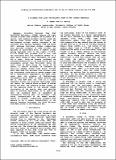Por favor, use este identificador para citar o enlazar a este item:
http://hdl.handle.net/10261/26938COMPARTIR / EXPORTAR:
 SHARE SHARE
 CORE
BASE CORE
BASE
|
|
| Visualizar otros formatos: MARC | Dublin Core | RDF | ORE | MODS | METS | DIDL | DATACITE | |

| Título: | A poleward flow along the Atlantic coast of the Iberian Peninsula |
Autor: | Haynes, R.; Barton, Eric D. CSIC ORCID | Fecha de publicación: | jul-1990 | Editor: | American Geophysical Union | Citación: | Journal of Geophysical Research - Part C - Oceans 95(7): 425-441 (1990) | Resumen: | Satellite Advanced Very High Resolution Radiometer (AVHRR) imagery and Argos tracked drifters have revealed the existence of a narrow, warm surface poleward current along the Iberian coast during autumn and winter. Six near‐surface drifter tracks indicated a net northward flow between September 1986 and March 1987, although individual drifter trajectories also provided evidence of eddy activity and episodes of equatorward flow. A SeaSoar survey during September 1986 in the region 37°–43°N, 9°–11°W showed that poleward flow at that time was associated with the northward advance of a warm, salty tongue of water throughout the upper 400 m layer. Infra‐red imagery confirmed the northward penetration of the warm current and its progression around Cape Finisterre along the north coast of Spain during the course of the winter. A similar situation is indicated by satellite imagery during other years. Current meter data show that poleward flow occurred along the continental slope down to depths greater than 600 m. Conductivity, temperature, and depth (CTD) casts show the presence of Mediterranean Intermediate Water (MIW) at depths greater than 600 m. The MIW does not flow as a simple northward flowing jet along the continental slope off Iberia, but instead shows evidence of eddies within the flow. The poleward surface current is in the opposite sense to the general summer circulation of the region, when cool upwelled water is advected equatorward. It is postulated that the poleward flow is generated by thermohaline forcing when the southward trade winds, characteristic of the summer months, weaken or reverse. Intermittent poleward flow appears to be a common characteristic of the Eastern Boundary throughout the North Atlantic from West Africa to the Norwegian Sea. | Descripción: | 17 páginas, 12 figuras, 3 tablas. | Versión del editor: | http://dx.doi.org/10.1029/JC095iC07p11425 | URI: | http://hdl.handle.net/10261/26938 | DOI: | 10.1029/JC095iC07p11425 | ISSN: | 0148-0227 | E-ISSN: | 2156-2202 |
| Aparece en las colecciones: | (IIM) Artículos |
Ficheros en este ítem:
| Fichero | Descripción | Tamaño | Formato | |
|---|---|---|---|---|
| haynes_barton1990jgr.pdf | 1,3 MB | Adobe PDF |  Visualizar/Abrir |
CORE Recommender
WEB OF SCIENCETM
Citations
251
checked on 16-feb-2024
Page view(s)
291
checked on 16-abr-2024
Download(s)
529
checked on 16-abr-2024
Google ScholarTM
Check
Altmetric
Altmetric
NOTA: Los ítems de Digital.CSIC están protegidos por copyright, con todos los derechos reservados, a menos que se indique lo contrario.
